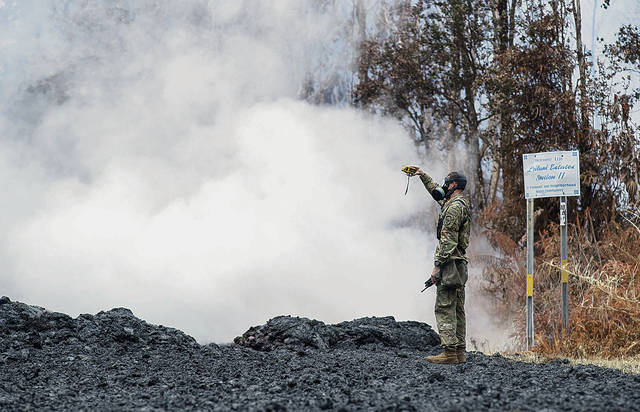Vog and acid rain add to Big Island concerns

CINDY ELLEN RUSSELL / CRUSSELL@STARADVERTISER.COM
U.S. Army National Guard Sgt. Milo Kalama measured the sulfur dioxide gas Wednesday near fissure No. 13 on Leilani Avenue at Leilani Estates. The fissure developed on Tuesday afternoon.
In addition to the threat of explosive eruptions at Kilauea’s summit, new vents and the wrath of lava, Hawaii island residents also have acid rain to worry about.
Rain forecast mostly for the windward side of Hawaii island today and Friday brings with it the possibility of sulfur dioxide from the volcanic vents mixing and reacting with water, creating acid rain.
Acid rain is rain that has been made acidic by certain pollutants in the air, including sulfur dioxide, according to the U.S. Environmental Protection Agency.
University of Hawaii meteorologist and professor Steven Businger said the rain is not dangerous.
> Star-Advertiser Kilauea volcano coverage: https://808ne.ws/2FIMk5c Opens in a new tab
> Hawaii-born MLB player Kolten Wong joins list of GoFundMe fundraisers: https://808ne.ws/2JXUg5h Opens in a new tab
> Science explains Kilauea https://808ne.ws/2wmIuzj Opens in a new tab
> Lava flow at Leilani Estates in Pahoa: https://808ne.ws/2rq0292 Opens in a new tab
> Photos from Leilani Estates as lava advances: https://808ne.ws/2whJ2GZ Opens in a new tab
> Residents in Nanawale Estates keep an eye on Pele: https://808ne.ws/2JTo8jm Opens in a new tab
Don't miss out on what's happening!
Stay in touch with breaking news, as it happens, conveniently in your email inbox. It's FREE!
RELATED VIDEO
> Leilani Estates resident talks about not evacuating Opens in a new tab
> AP: Lava flow oozes onto Hawaii pavement Opens in a new tab
> Hawaii island residents monitor Kilauea flow Opens in a new tab
> Aerial footage of lava flowing into Leilani Estates on May 6 Opens in a new tab
> Leilani Estates home goes up in flames after lava strikes Opens in a new tab
> East Hawaii residents brace as 6.9 quake hits Opens in a new tab
> Crack opens in road, lava flows in Leilani Estates Opens in a new tab
> Puu Oo vent empties Opens in a new tab
“If you’re wearing clothing, there’s no risk,” he said. “It’s not going to burn your skin … It might irritate your eyes if you look up and get raindrops in your eyes.”
Coqui frogs and geckos, on the other hand, are very sensitive to acid rain, he said, and fish in ponds can suffer from long-term exposure. In addition, acid rain damages vegetation and causes tools, barbed-wire fencing and items that can rust to do so a lot faster.
Light winds may allow volcanic haze to become more widespread on the Big Island through Friday night, but weather forecasters said there did not appear to be enough southeast flow to carry the vog to other islands. By late Friday night or Saturday morning, tradewinds should be back, helping to push the vog out to sea.
The primary pollutants in vog, or volcanic smog, are sulfur dioxide gas and fine particulate matter.
The American Lung Association warned the public that sulfur dioxide can have harmful effects on the lungs and cause respiratory problems. Sulfur dioxide irritates the nose, throat and airways to cause coughing, wheezing, shortness of breath or a tight feeling around the chest — and can trigger asthma attacks.
The effects of sulfur dioxide can be felt very quickly, according to the association, and are especially harmful to children, older adults and people with respiratory conditions.
A two-person team from the Hawaii and Arizona National Guards monitored air quality near fissures in Leilani Estates Wednesday and found no dangerous levels of sulfur dioxide.
Sgt. Milo Kalama of the Hawaii National Guard’s 93rd Weapons of Mass Destruction-Civil Support Team approached a steaming fissure on Leilani Avenue wearing a black, full-face mask. As his air-monitoring equipment buzzed, Kalama removed his mask and declared the air quality normal.
Kau Hospital and Rural Health Clinic reported an uptick in the number of patients with respiratory illness in the emergency room and clinic.
“They’re having difficulty breathing and respiratory issues. It’s starting in Kau,” said hospital spokeswoman Elena Cabatu. “People please continue to heed civil defense warnings and read up on the precautions they can take. We’re definitely monitoring our supplies very closely and taking inventory of respiratory therapy supplies. We’re making sure we’re stocked so we’re ready to go.”
Hilo Medical Center, however, has not seen an increase in respiratory patients, she said.
The state Health Department has placed sulfur dioxide and particulate monitoring equipment around the eruption site. Once it is up and running, air quality data from the site will become available online.
Honolulu Star-Advertiser writers Dan Nakaso and Kristen Consillio contributed to this report.





